Soft Scale Species Controls (June & July): Compared to armored scales, the soft scales are relatively easy to suppress with either contact sprays or systemic treatments. Some of the common landscape soft scale species in NJ include calico, Fletcher, Indian wax, cottony maple, cottony camellia, spruce bud, European fruit lecanium, pine tortoise, striped pine, magnolia, & tulip tree. Although large soft scale adult females are more difficult to control, the immature nymphs are often vulnerable to sprays when good coverage is achieved. However, there are some species that have proven to be more challenging to control. Two good examples include the calico scale & Indian wax scale species. Horticultural oil sprays are often recommended to control immature scale nymphs, but sometimes against the calico & Indian wax species the efficacies are less consistent. This blog will first review soft scale management options & then show photographs & discuss the life cycles of the following soft scale species with crawlers emerging during June & July: (1) Indian wax, (2) calico, (3) cottony camellia, (4) spruce bud, & (5) Fletcher.
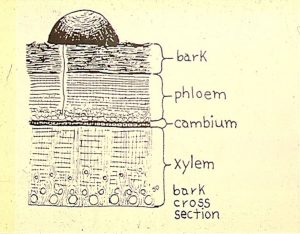
Drawing of a soft scale feeding on woody bark. All soft scale species suck sap from phloem vascular tissues. (Drawing Credit: John Davidson, University of Maryland)
Insecticide Management Options: There are numerous windows of control when applying contact sprays or systemic treatments against soft scales.
(1) The best window for control when using spray treatments is toward the crawler emergence period. With only two major exceptions (Magnolia & Tulip tree scales), all other soft scale species produce crawlers primarily during the months of June or July. Although scale crawlers are less than twice the size of spider mites, they are usually clearly visible without magnification. Most crawlers have a yellowish or reddish coloration.
(2) Sprays can also be successfully targeted against the settled 1st instar nymph stage feeding on foliage or bark during the growing season. Achieving adequate coverage to foliage is the major challenge with large deciduous shade trees since many of the soft scale species have nymphs that settle & feed on the undersides of leaves along major veins.
(3) In addition, dormant oil treatments can be applied in the late fall or early spring to the over-wintering 2nd instar nymphs on deciduous hosts. These nymphs have a black or brown coloration and are considerably larger than the crawlers and 1st instar nymphs. They can be observed in clusters on the bark of twigs, branches, or trunks.
(4) Finally, since soft scales are vascular feeders (mostly phloem & some xylem), root absorbed systemic insecticides such as imidacloprid (Merit) or dinotefuran (Safari) have provided better than 90% control rates. However, some inconsistent results have been seen with calico scales. Root systemic treatments can be applied as a drench or be soil injected any time during the year if the ground is not frozen. Fall or spring applications are most typical. Having adequate soil moisture is a key factor to ensure success when applying root systemic treatments.
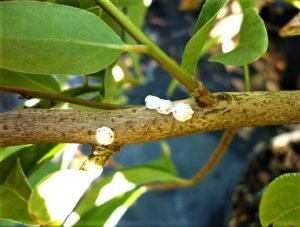
An easily observed small group of Indian wax scales clustered together feeding on a branch stem. (Photo Credit: Steven K. Rettke, Rutgers Coop’ Ext.)
(1) Indian Wax Scale (Ceroplastes ceriferus)(700-1200 GDD = crawler emergence): Within NJ nurseries, this soft scale commonly feeds on branches of inkberry holly & Japanese maple. Can also be found on Chinese & Japanese hollies, azaleas, pyracantha, euonymus, boxwood, flowering quince, camellia, pear, azalea, persimmon, plum, barberry, and magnolia. Large females overwinter on stems & lay eggs during the late weeks of spring. Pinkish colored crawlers begin to emerge during June & may continue into July. Thirty or more years ago, it was unusual to see Indian wax scales north of Virginia. The warmer winter temperatures during the past few decades have allowed this species to migrate northward & successfully overwinter in New Jersey.
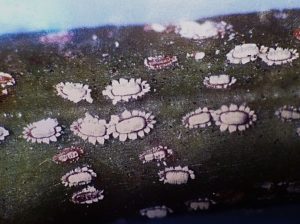
The recently settled 1st instars of Indian wax scales form a cameo appearance as they are only partially covered with white wax. (Photo Credit: Cornell University)
After settling on stems, the 1st instar nymphs will excrete a white wax that partially covers the body, giving the scale a distinctive “cameo” appearance. Eventually a thick, gummy, white wax completely covers the adult red colored females. As is true with all soft scale species, the waxy or leathery exoskeleton cannot be separated from the scale body unlike the covers of armored scales. Also, as with all soft scales, they are phloem feeders & will exude honeydew as they grow & develop.
All life stages of the Indian wax scale feed only on woody stems & will not be found on leaves. Dormant horticultural oil does not work well on this scale. The exceptionally thick wax does not allow the oil to contact the body of the scale. Distance applied when crawlers are present works well. Imidacloprid (Merit) can also be applied as a soil drench in April. It takes 30 – 60 days for uptake into the stems of larger plants. Soil application of dinotefuran (Safari) is up taken in less than 2 weeks and should give excellent control. Acetamiprid is an EPA reduced-risk insecticide & is labeled against this scale.
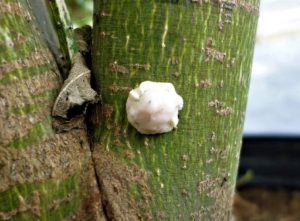
The distinctive, large gum-ball shaped waxy exoskeleton of the Indian wax scale. (Photo Credit: Steven K. Rettke, Rutgers Coop. Ext.)

A Indian wax scale removed from the plant & turned-over. The thickness of the white waxy covering the red body is evident. (Photo Credit: Steven K. Rettke, Rutgers Coop. Ext.)
(2) Calico Scale (Eulecanium cerasorum)(700-1200 GDD = crawler emergence): The calico scale is a native soft scale species & can be found infesting a wide range of trees. Some common examples include honey-locust, maple, sweetgum, dogwood, crab apple & various fruit trees. Calico scale females spend the winter as small, dark colored 2nd instar nymphs on woody stems & branches. Up-close monitoring is required to observe their presence. During the spring, the nymphs mature & increase their size significantly. As they feed in the phloem, large quantities of honeydew can be exuded that will rain down on anything beneath them. During the later spring weeks, they reach the peak of their black & white spotted “calico” coloration This soft scale species is relatively large & can reach ¼-inch in size. During the early summer, after laying many hundreds or possibly thousands of eggs, the females die & their leathery exoskeleton darkens as they lose their “calico” coloration. The dead females can then often be mis-identified as European fruit lecanium scales.
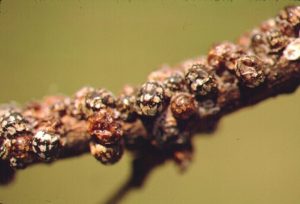
Mature Calico scale females feeding on branch stems are plumped-up & preparing to lay eggs. The black-white “calico” coloration is most prominent during this stage. (Photo Credit: Steven K. Rettke, Rutgers Coop. Ext.)
Eggs hatch & crawlers will emerge during late June & continue into July. They travel & settle onto leaves & can typically be observed lined-up along leaf veins. The use of a 10X hand-lens will be useful when identifying the translucent 1st instar nymphs. There is only one generation per year & these nymphs will continue to feed throughout the summer months. During the end of the year before the leaves defoliate, the nymphs will travel back again to stems & branches where they overwinter as 2nd instar nymphs.
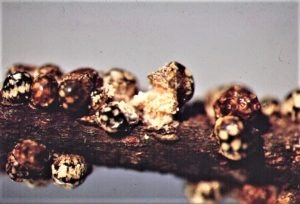
Thousands of calico scale eggs will hatch & emerge as crawlers from under dead female body. After hatching, crawlers will migrate to leaves & feed along leaf veins. (Photo Credit: Steven K. Rettke, Rutgers Coop. Ext.)

Larger, dark colored 2nd instar soft scale nymphs migrated from leaves to overwinter on branches & stems. They are highly vulnerable to predators during this stage. (Photo Credit: Steven K. Rettke, Rutgers Coop. Ext.)
Although soft scale species compared to armored scales are generally thought to be relatively easy to control, this is often not the case with both the calico & Indian wax scale species. Like the Indian wax scales, the calico scale is dishearteningly not effectively controlled with horticultural oils. This also the case with dormant oil applications. The high variability in insecticide efficacy with other materials has been reflected in the results of trials conducted by university researchers. For example, various systemic neonicotinoid insecticides that are effective against other soft scales have produced highly variable results against calico scale. Dinotefuran (e.g., Safari) produced satisfactory results in some university efficacy trials while delivering no control in others. Other trials which targeted crawlers attached to the undersides of leaflets in July have shown poor results & failed to achieve acceptable controls using either dinotefuran or an insect growth regulator (IGR) insecticide. Only Onyx (bifenthrin) provided good results, but inconsistencies using this product have also occurred. (Reference: Ohio State Coop. Ext., Calico Scale Fact Sheet by Joe Boggs)
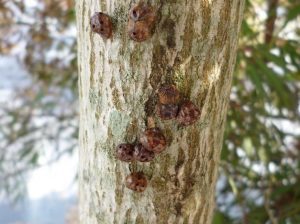
Evidence of valuable biological controls. The numerous exit holes indicate parasitoid wasps have successfully destroyed these mature calico scales. (Photo Credit: Steven K. Rettke, Rutgers Coop. Ext.)
Soft Scales & Deciduous Trees: Magnolia, tulip tree, calico, lecanium, & cottony maple are all examples of soft scales that over-winter as nymphs on stems or branches of mostly deciduous trees and shrubs. Magnolia & tulip tree scales only feed on stems, but before leaves drop in the fall, the other scale species crawlers move back from the leaves to the bark where they will spend the remaining part of their life cycles. Although there are exceptions, the consensus is that late fall &/or winter dormant oils are particularly effective against soft scale 2nd instar nymphs that overwinter on branches.
During the summer months, monitor for the presence of 1st instar nymphs before spraying by investigating further when the black sooty mold on needles, twigs or branches are first observed. Close inspection of the undersides of leaves is required since the nymphs are often translucent & difficult to see. Avoid blind cover sprays in order to conserve beneficials. Predators and parasitoids can often effectively control soft scale populations when not destroyed by unnecessary sprays.
(3) Cottony Camellia Scale (Pulvinaria floccifera)(802-1388 GDD = crawler emergence)(PPI = Kousa Dogwood – end bloom): This scale is mostly found on holly, yew, euonymus, camellia & maple. Another common name is the cottony taxus scale. It gets its name from the conspicuous oval, ¼-inch white, cottony wax ovisacs (eggs) extending from the adult female. There can be over one thousand eggs contained within each of these ovisacs, which are laid on the underside of leaves in late spring. After egg laying concludes in June, the 1/8-inch yellow-tan cottony camellia scale female dies & often falls off leaving only the white cottony ovisac where crawlers will emerge.
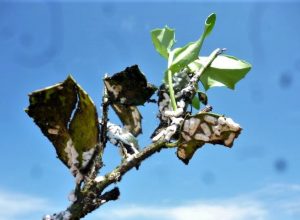
Extreme populations of cottony camellia scale feeding primarily on undersides of leaves. (Photo Credit: Steven K. Rettke, Rutgers Coop. Ext.)
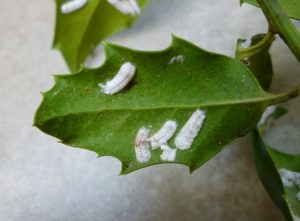
Cottony camellia scale white ovisacs may contain many hundreds of eggs. (Photo Credit: Steven K. Rettke, Rutgers Coop. Ext.)
Eggs hatch & the crawlers emerge during June & July. There is only one generation a year, which is true for essentially all soft scales in NJ. Look for crawlers on the undersides of the leaves & for honeydew & sooty mold. Cottony camellia scales primarily will be found on leaves. With extreme populations they can sometimes be seen feeding on stems. When monitoring, be certain to focus on leaf undersides, especially near the lower portions of the plant. Symptoms include foliage turning a light green-yellow color & some dieback of twigs or branches.

Close-up of a single cottony camellia egg ovisac. Dead female has already detached & fallen-off leaf. Evidence of emerged crawlers can be seen. (Photo Credit: Steven K. Rettke, Rutgers Coop. Ext.)
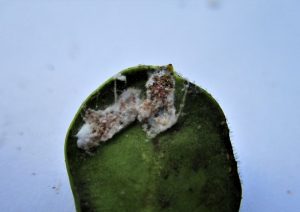
White wax scraped away from ovisac reveals the numerous eggs & some emerging crawlers migrating onto leaves. (Photo Credit: Steven K. Rettke, Rutgers Coop. Ext.)
When plentiful, beneficial parasitoid wasps, which are essentially parasites that kill their hosts, can provide significant suppression of scales (i.e., if they are not destroyed via unwarranted pesticide use). If heavy honeydew & sooty mold build-up becomes a problem, then horticultural oil &/or insecticidal soap should be applied to conserve the beneficials. A dormant oil can be sprayed next winter, targeting the immatures overwintering on the undersides of evergreen leaves. If deciduous trees are infested, then the oil sprays will need to target immatures on stems. Soil applied systemic insecticides can also be effective. The reduced-risk insecticide acetamiprid is labeled for use against this scale insect.
(4) Spruce Bud Scale (Physokermes hemicryphus)(912-1388 GDD = crawler emergence):
Spruce bud scale is a non-native insect usually found on Norway spruce (Picea abies) but will also attack other spruce species. The origin of spruce bud scale is Europe, which is also the native range of Norway spruce. Another soft scale with only a single generation, in NJ the crawlers emerge in late June & continue into the weeks of July. As with all soft scale species, they suck phloem sap & exude honeydew that can promote black sooty mold. The occurrence of wasps, bees, hornets & ants attracted to the honeydew can serve as a good field indicator for the presence of spruce bud scale on spruce.
These scales are found in nodes at the base of new shoots. During the early weeks of spring the young light-brown females appear globular or oval-shaped & can easily be mistaken as unopened buds. They may be found singly or clustered in a group of two to eight around the nodes of new or last season’s growth. If only one or two scales are feeding at an internode usually little damage will occur. However, if the internodes are surrounded with 4 to 8 scales, then branch shoots can be stunted. Heavy scale infestations can significantly weaken lower branches reducing overall tree vigor and increasing susceptibility to damage from other insects and disease.
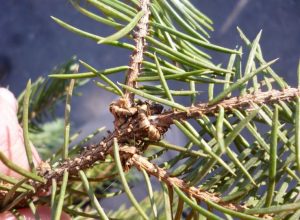
During the early maturing stages, the spruce bud scales remarkably look like unopened leaf buds. If only 1 or 2 scales are at a shoot internode, then damage potential will be minimal. (Photo Credit: Steven K. Rettke, Rutgers Coop. Ext.)
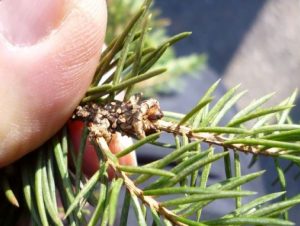
Howerever, when spruce bud scales encircle an internode with 4 to 8 scales, then branch stunting is more likely. Weaker trees may even show dieback. (Photo Credit: Steven K. Rettke, Rutgers Coop. Ext.)
When monitoring during April, May & into June, look for young feeding female scales on spruce at the most recent shoot internodes. At this time, the light-brown scales resembling buds will feel soft to the touch. As eggs fill their bodies, they become rounder and darken to a reddish-brown color. When the females die in late June, they become brittle & hollow upon examination.
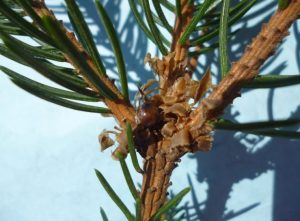
Mature spruce bud scale has reached a large, plumped-up stage when they are most recognizable. Egg laying will soon occur. (Photo Credit: Steven K. Rettke, Rutgers Coop. Ext.)
Eggs contained within the dead female body hatch from late June to July in NJ. The young crawlers migrate to the needles, insert their feeding tubes, and suck sap actively feeding through September. Spruce bud scale over-winters as nymphs on the undersides of needles or clustered around terminal and lateral buds. In the spring, females settled at the base of buds grow quickly in size and secrete honeydew as they feed.
When spruce bud scales are mild & only a few trees are infested, then physically removing scales primarily at lower branches before eggs hatch in late June can prevent future problems. With higher scale populations & many trees involved, then horticultural oils or insecticidal soaps can be applied in early July to kill crawlers on new shoots. Concentrate sprays to lower branches where most scales will be located. Dormant oils can also be applied against nymphs on the undersides of needles around terminal & lateral buds. Soil applied systemic insecticides can be effective against this scale. (Reference: Bartlett Tree Experts, Spruce Bud Scale Technical Report by Kelby Fite)
Ants & Honeydew Producers vs. Predators: Various pests such as aphids, soft scales, mealybugs, and whiteflies are plant feeders that insert their piercing-sucking mouthparts into vascular tissue (phloem) to remove plant sap from leaves or stems. Since phloem sap is not nutrient rich in proteins, plant pests must withdraw large quantities to maintain growth and reproduction. As a result, to avoid blowing-up into “Macy’s Thanksgiving Day Balloon Floats” these insects must also expel copious amounts of unwanted waste called honeydew. The post-digested honeydew still contains a lot of sugary carbohydrates and is valued by ants, wasps, bees, and other vespids as a food source. The honeydew is often easily observed as a clear, shiny, and sticky material on foliage. The honeydew usually darkens over time as a black sooty mold fungus grows on the liquid droppings.
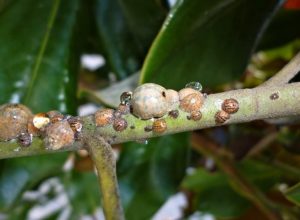
The honeydew oozing-out of these magnolia soft scales is clearly observed. (Photo Credit: Steven K. Rettke, Rutgers Coop. Ext.)
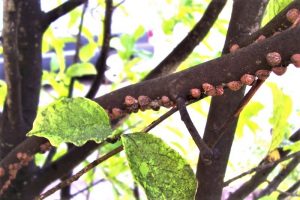
As soft scales exude the honeydew onto leaves & branches, a black sooty mold may soon after grow on the surface. (Photo Credit: Steven K. Rettke, Rutgers Coop. Ext.)
Numerous predators and parasitoids including ladybeetles, lacewings, flower flies and wasp parasites (parasitoids) typically attack and consume honeydew-producing pests. Carpenter ants and other colony ant species have waged vicious wars for “eons” against predators of honeydew producers. Certain ant species will expend a lot of energy and effort to protect honeydew producers and prevent effective biological control. (An analogy would be the sheep herder who protects their flock against wolfs.) As a result, to help restore the predator vs. prey balance in the landscape, it may be necessary for the pest manager to intervene and seek out ant colony locations to apply controls. Alternatively, spraying a pyrethroid around the circumference at the base of a tree can prevent ant movement up the trunk.
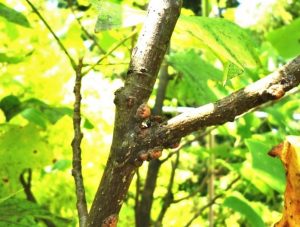
An ant drinks from a pool of honeydew formed at branch fork. The magnolia scale above exuded the honeydew. (Photo Credit: Steven K. Rettke, Rutgers Coop. Ext.)

To protect the tuliptree soft scales from predators, ants built the dark colored “soil condos” to help fight-off the “wolfs.” (Photo Credit: Steven K. Rettke, Rutgers Coop. Ext.)
When the infestations are light and sprays are required, apply horticultural oils or insecticidal soaps. In heavy infestations, spray a residual insecticide, adding soap to the tank to dislodge the honeydew and sooty mold. Using necessary precautions, oils & soaps can be mixed to provide a synergistic effect.
(5) Fletcher Scales on Yew/Taxus (Parthenolecanium fletcheri)(1029-1388 GDD = crawler emergence): The native Fletcher soft scale usually attacks arborvitae and especially yew, but have also been found on junipers, cypress & hemlock. However, the largest & most damaging populations will occur on yew. Although Fletcher & European fruit lecanium scales appear similar, they should never be confused since one will only feed on conifers while the other exclusively feeds on deciduous plants.
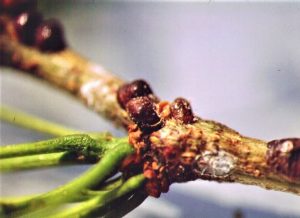
Fletcher scales will typically cause the greatest potential damage to Taxus (yew). The white ring indicates where a scale was removed. (Photo Credit: Cornell University).
During the past few weeks, this soft scale has been laying eggs that have already begun to hatch in south Jersey & crawlers will continue to emerge into the mid-weeks of July throughout the state. One female may deposit an average of 500-600 eggs. Eggs hatch into oval, flat, amber to yellow first instar crawlers that migrate a short distance on a branch until settling on needles within 48 hours. Immature scales grow quickly and produce much honeydew, which results in foliage becoming covered with black sooty mold. During the summer months, look on needles & outer twigs for the small, flat settled nymphs. This pest overwinters as second instar nymphs on foliage or twigs.
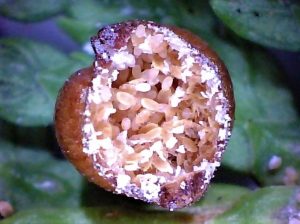
Hundreds of unhatched eggs will soon emerge as crawlers from under the dead Fletcher scale body. (Photo Credit: Steven K. Rettke, Rutgers Coop. Ext.)
During the spring weeks of April, May & June, monitor for hemispherical, 1/8 inch, yellow-brown adult scales. Also, concentrate inspections on twigs showing dieback damage and needle yellowing. The full grown hemispherical shaped 3/16-inch females will die by the end of June, but they can remain attached on the host plant for the remainder of the season. This species has no males & reproduces by parthenogenesis. One generation is produced each growing season in New Jersey.
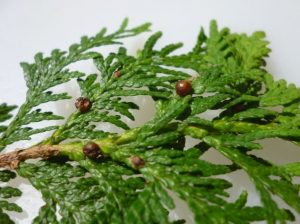
A few mature Fletcher scales can be easily observed feeding on this arborvitae branch. (Photo Credit: Steven K. Rettke, Rutgers Coop. Ext.)
Overwintering second instar nymphs may be managed with a dormant rate of horticultural oil applied according to label directions in early spring before new growth occurs. Apply a foliar absorbed insecticide against the crawler stage from late-June through the month of July. Repeat applications may be needed. Soil injection or drenching with a registered systemic insecticide labeled for management of this pest can be effective. Spring soil applications of systemics are most effective with adequate soil moisture. (Reference: Penn State Coop. Ext., Fletcher Scale Fact Sheet by Greg Hoover)

